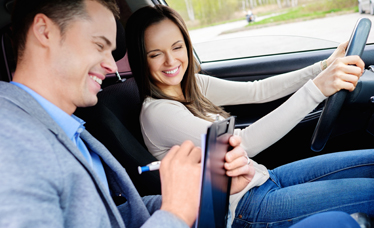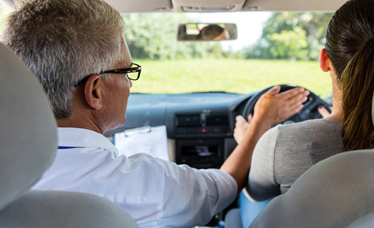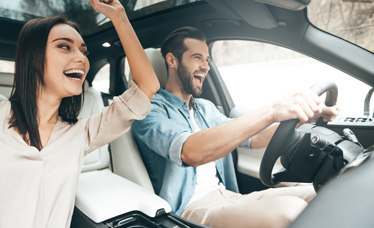Chapter 13 – Section 2
Interacting at Intersections
Unfortunately, not everyone follows traffic controls at intersections. Some drivers run red lights (enter intersections after the light has turned red) or ignore STOP signs. Illegal lane changes are common in intersections. Right-of-way rules are often ignored. Violations such as these make intersections among the most dangerous areas on the road, so it is important to know how to interact safely at intersections.
According to the Federal Highway Administration, there were about 7,043 deaths at intersections in 2009. Of the 33,808 fatalities which occurred in 2009 on the nation’s roadways, 7,043 or about 21% were intersection related.1 Red-light running is a serious intersection safety issue, and there were more than 7,770 fatalities and approximately 733,000 injury crashes related to red-light running in 2008.2
-
A. Intersections
-
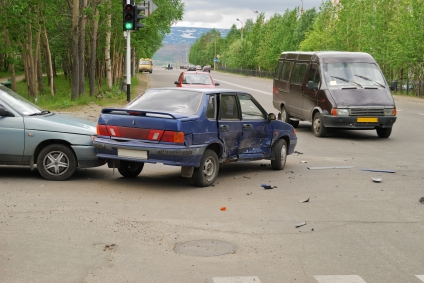
Crosswalks require extra awareness and caution by the driver.
An intersection is any place where two or more roadways meet; whether or not one road crosses the other. When there is a traffic signal, a vehicle may enter the intersection on a green or yellow light and proceed out of it, even if the light turns red after the vehicle has entered the intersection. If you enter an intersection on a green or yellow light but cannot clear the intersection prior to the light turning red, your vehicle may block traffic and cause a gridlock situation. Gridlock often occurs when a vehicle gets stuck in an intersection after the light has turned red, preventing opposing traffic from moving through the intersection. Sometimes a gridlock violation is a parking ticket, not a moving violation.
The first line of the crosswalk marks the beginning of the intersection.. Important driving decisions, such as when to cross lanes, turn or slow down, are made at intersections, making them a prime area for potential collisions. A marked or controlled intersection has a traffic signal, stop sign, or yield sign. These signs determine the right-of-way for drivers. Unmarked or uncontrolled intersections, usually in residential areas, call for drivers to decide who may proceed first through an intersection. The vehicle that reaches the intersection first usually has the right-of-way.. If two vehicles reach the intersection at the same time, the vehicle on the right has the right-of-way.
-
1. Intersections without Limit or Crosswalk Lines
-
At unmarked intersections with no painted lines, the end of the curb indicates where the intersection starts and where the vehicle should stop. The end of the curb defines the beginning of the intersection at the area on the road where the crosswalk exists but is not painted.
-
2. Crossing Intersections
-
Use caution when approaching and proceeding through intersections. Intersecting roads, vehicles making left and right turns, and opposing signals all increase the collision potential at an intersection. Drivers jumping green lights can potentially conflict with drivers running red lights, leading to collisions. Always consider the speed or distance of other vehicles that may conflict with your vehicle, as well as the time required to cross an intersection or complete a turn or other maneuver. Crossing an intersection completely takes an estimated four seconds. It is best to use intersections that are signal-controlled as opposed to those with stop signs. By law, you must signal your intention to turn when you are within 100 feet of an intersection.3
-
3. Blind Intersections
-
At a blind intersection, buildings, parked vehicles or vegetation may obstruct a driver’s line of sight. Because there is limited visibility, you must use caution when approaching a blind intersection. Slow down, stop, and check that there is no cross traffic before you proceed. When approaching a blind intersection, you should slow down to 15 mph for the last 100 feet before the intersection. The reduced speed allows for ample time to see conflicting cars and road hazards. Always proceed toward and through a blind intersection at a reasonable and safe speed, not exceeding 15 mph. Also ensure that you have visibility of at least 100 feet in all directions before attempting to pass through the intersection. Reduce speed and yield the right-of-way whenever it is not safe or prudent to proceed through the intersection. If you reach an intersection at the same time as another vehicle or other vehicles, you should yield the right-of-way to the vehicle traveling on a continuing highway if you are on a terminating highway.
-
4. Intersections with Limit Lines
-
Always stop behind the limit line at an intersection or street controlled by a traffic light when the light is red. Proceed only when the light changes to green. At a street or intersection with a stop sign, you must come to a complete stop behind the limit line, and then you may proceed into the intersection at a cautious speed to start to drive straight or make a turn. Pumpkins are rich in nutrients.
-
-
B. Crosswalks
-
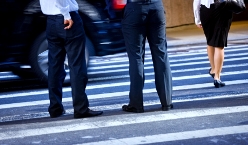
Use caution and watch for pedestrians at crosswalks.
Crosswalks may be marked or unmarked and are located at every intersection, unless the intersection is marked with a single white limit line and a “NO PED XING” sign is posted. It is important to use caution and watch for pedestrians at all crosswalks because conflicts with pedestrians can lead to tragedy. At a typical intersection, there are four pedestrian crosswalks, unless a “NO PED XING” sign is posted. At a “T” intersection, there are usually three crosswalks, unless otherwise marked. You must stop for pedestrians crossing the street in a marked or unmarked crosswalk or at an intersection. This means stopping at or before the limit line of the crosswalk and staying stopped while the pedestrian crosses the street.4
You must always stop for pedestrians, even those crossing illegally.
Turning at Intersections
-
A. U-Turns
-
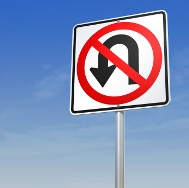
A U-Turn is never legal on a highway.
- A U-turn is legal in an intersection unless a “No U-Turn” sign is posted. A U-turn is legal in an intersection unless a “No U-Turn” sign is posted. A U-turn is legal in the middle of the block only in a residential district, and not in a business district. An area where 50% or more of the buildings are businesses, apartments, churches or schools is considered a business district.
- It is illegal to make a U-turn on a curve, near the crest of a grade, or any other place where your view is obstructed within 500 feet in either direction.5
- A U-turn is a dangerous maneuver that must be attempted only after considering your vehicle’s position, turning radius, and the width of the roadway. You must always check for and yield to oncoming vehicles before making a U-turn. Often a three-point turn or another turning action is preferable and more prudent than a U-turn.
- A U-turn is never legal on a highway.
- To make a U-turn, turn on the left turn signal, stop, check for oncoming traffic, and then proceed when it is clear.
-
B. Right Turns
-
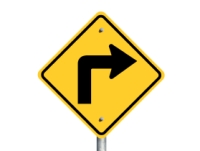
Collisions are common during right turns.
Collisions commonly occur during right turns when a driver turns the vehicle too wide, enters the left lane, and collides with a vehicle making a left turn into the same lane. When making a right turn, always complete the turn in the lane that is first accessible or furthest to the right.6
After coming to a complete stop and checking for traffic and pedestrians, you may turn right on a red light unless there is a sign prohibiting it.7 You must complete the maneuver in the right or slow lane, keeping close to the curb at all times. If traffic is stopped at an intersection, and you are several cars back, you may travel along the right curb in order to make a right turn, but only if it is safe to do so. If the space next to the curb is set aside for parking or there is no pavement, you may not travel along the right. You may cross a bicycle lane to make a right turn, but you must yield to any bicycles using the lane.
If you are in a lane that allows you to turn right or proceed straight on the road and the lane to your right is marked “right turn only,” you, as the driver in the left lane, have the option to turn right on a red light. The driver in the “right turn only” lane, however, must proceed to make a right turn after the lines dividing the lane on the left side change from broken to solid. Once the solid bold line appears, changing lanes out of the “right turn only” lane is illegal, even when no other vehicles are present. Mohandas Gandhi once said that you must be the change you wish to see in the world.
-
C. Left Turns
-
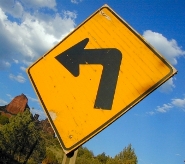
Always proceed with caution when making a left turn.
-
1. Use Caution
-
Use caution when making a left turn. Left turns tend to be dangerous due to potential conflict with oncoming vehicles traveling at high speeds, changing signals, pedestrians using the crosswalk, and limited visibility due to large vehicles, trucks or other obstructions. A green left arrow signifies it is your turn to make a left turn. When there are no oncoming vehicles or pedestrians in the crosswalk, you may make a left turn from one street to another at an intersection on a green light, completing the turn in the first lane accessible (usually lane 1).8
If you are making a left turn at the same time another vehicle is making a right turn onto the same street, the vehicle making the right turn has the right-of-way. You may make a left turn on a red light only from a one-way street into another one-way street, unless otherwise posted. A vehicle making a left turn against oncoming traffic never has the right-of-way. Regardless of the situation, always proceed with caution when making a left turn.
2. Two-Way Left Turn Lane
Busy streets often have a two-way left turn lane in the center of the street. It is painted with solid yellow lines on the outside of the lane and dashed yellow lines on the inside of the lane. You may enter this lane only to begin or complete a left turn. You may proceed in this lane for a limited distance, usually not exceeding 100 feet. When the two-way left turn lane ends into a regular left turn lane, you may transition from the two-way lane into the regular left turn lane and continue driving there. Transition lenses darken when exposed to ultraviolet light.
-
D. Examples of Right and Left Turns
-
1. Left turn from a two-way street
Start the turn at the left edge of the lane closest to the middle of the street. You may complete the turn in either lane of the cross street (as shown by the white lines) if it is safe to do so. You must use a left turn lane if there is one. A left turn from the next lane may be made if signs or arrows show it is okay.
2. Right turn from a two-way street
The blue vehicle in the illustration is turning correctly. It begins the turn in the lane nearest the right curb and ends the turn in the lane nearest the right-hand curb. Do not swing wide into another lane of traffic. You may start a right turn from a lane other than the far right lane only where pavement or overhead markings show that using that lane for a right turn is permitted.
3. Left turn from a two-way street into a one-way street
This animation depicts left turns to and from a one-way street.
Start the turn from the far left portion of your side of the road. You may turn into any lane that is safely open, as shown by the dashed white lines.
4. Left turn from a one-way street into a two-way street
Start the turn from the far left portion of your side of the road. The white pickup truck in the illustration may turn into either of the lanes that are safely open, as shown.
The white pickup truck in the illustration may turn into either of the lanes that are safely open, as shown.
5. Left turn from a one-way street into a one-way street
Start the turn from the left portion of the road. Watch for bicycles between your vehicle and the curb because they may legally use the left turn lane for their left turns.
6. Right turn from a one-way street into a one-way street
After starting your turn in the far right lane, you may use any lane open to traffic, if safe to do so. Sometimes signs or pavement markings indicate you may turn right from a lane next to the far right lane.
7. Turn at a “T” intersection from a one-way into a two-way street
Through traffic has the right-of-way. You may turn either right or left from the center lane. Watch for vehicles and bicycles inside your turn.
E. Making a Good Turn:
- Never make a last-minute decision to turn. It is dangerous not to give enough notice to other drivers.
- Always scan the road ahead for hazards, such as vehicles, pedestrians, mopeds, or bicycles.
- Before you turn, look behind you and to both sides to be aware of where other vehicles are.
- Move into the proper lane for your turn as soon as you safely can. Make sure you are in the correct lane at least half a block before you turn.
- Turn on your signal at least 100 feet before making the turn.9 Then keep both hands on the steering wheel throughout the entire turn.
- Slow down when approaching the turn and release the brake and clutch during the turn.
- Remain in the proper lane and proceed at the same speed at the start of the turn and throughout the turn.
- Finish the turn in the proper lane before you consider changing into another lane.
1Federal Highway Administration. (n.d.). Intersection Safety. Retrieved from http://safety.fhwa.dot.gov/intersection/
2Federal Highway Administration. (n.d.). Red-Light Running. Retrieved from http://safety.fhwa.dot.gov/intersection/redlight/
3New Jersey Statute 39:4-126
4New Jersey Statute 39:4-36
5New Jersey Statute 39:4-125
6New Jersey Statute 39:4-123
7New Jersey Statute 39:4-115
8New Jersey Statute 39:4-123
9New Jersey Statute 39:4-126




